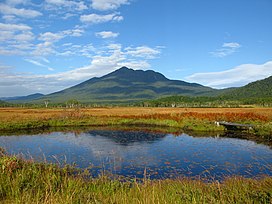Hiuchigatake: Difference between revisions
update template syntax; Clean up duplicate template arguments using findargdups |
m →top: |native_name= fix |
||
| Line 3: | Line 3: | ||
| name = Hiuchi |
| name = Hiuchi |
||
| other_name =Mount Hiuchigatake |
| other_name =Mount Hiuchigatake |
||
| native_name = |
| native_name ={{native name|ja| |
||
| native_name_lang = ja |
|||
| photo = Hiuchigatake 080923 4.JPG |
| photo = Hiuchigatake 080923 4.JPG |
||
| photo_size = |
| photo_size = |
||
Revision as of 16:31, 10 January 2022
| Hiuchi | |
|---|---|
| Mount Hiuchigatake | |
 | |
| Highest point | |
| Elevation | 2,356[1] m (7,730 ft) |
| Coordinates | 36°57′7″N 139°17′19″E / 36.95194°N 139.28861°E |
| Naming | |
| Native name | |
| Geography | |
Honshu, Japan | |
| Geology | |
| Age of rock | Quaternary |
| Mountain type | Stratovolcano[2] |
| Last eruption | July 1544[1] |
Hiuchi, also Hiuchigatake (Japanese:
Morphology
Hiuchi initially formed around 350,000 years ago. Around 160,000–170,000 years ago, Hiuchi erupted, creating a large pyroclastic flow deposit. At the summit of the volcano lie two lava domes, Akanagure (
Historic eruptions
1544 eruptions
The only recorded activity was on July 28, 1544. A moderate phreatic eruption at the Mi-ike Lava Dome produced lahars and an associated tephra layer.[1][5]
See also
- Asteroid 6883 Hiuchigatake, named after Hiuchigatake
- List of volcanoes in Japan
- List of mountains in Japan
References
- ^ a b c "Hiuchigatake: National catalogue of the active volcanoes in Japan" (PDF). Japan Meteorological Agency. Retrieved 2017-12-13.
- ^ a b "
燧ヶ岳 " (in Japanese). kotobank. Retrieved 2017-12-13. - ^ "Oze National Park_Guide of Highlights [MOE]".
- ^ "
日本 百名山 " (in Japanese). kotobank. Retrieved 2017-12-13. - ^ Yukio Hayakawa (1994). "
燧ヶ岳 で見 つかった約 500年 前 の噴火 堆積 物 ".火山 (in Japanese). 39 (5). doi:10.18940/kazan.39.5_243.
Further reading
- "Eruptive History of Hiuchi Volcano". Journal of Geography (Chigaku Zasshi). 106 (5): 660–664. 1997. doi:10.5026/jgeography.106.5_660.
{{cite journal}}: Unknown parameter|authors=ignored (help)
External links
- National catalogue of the active volcanoes in Japan: Hiuchigatake - Japan Meteorological Agency
- Quaternary Volcanoes: Hiuchigatake - Geological Survey of Japan, AIST
- "Hiuchigatake". Global Volcanism Program. Smithsonian Institution. Retrieved 2021-06-24.
- Volcanolive.com




